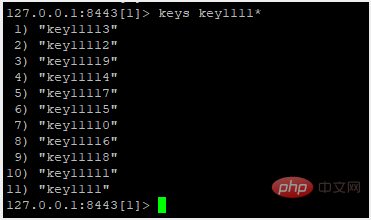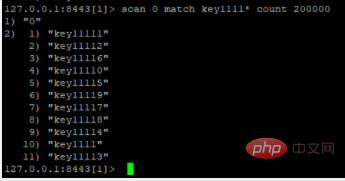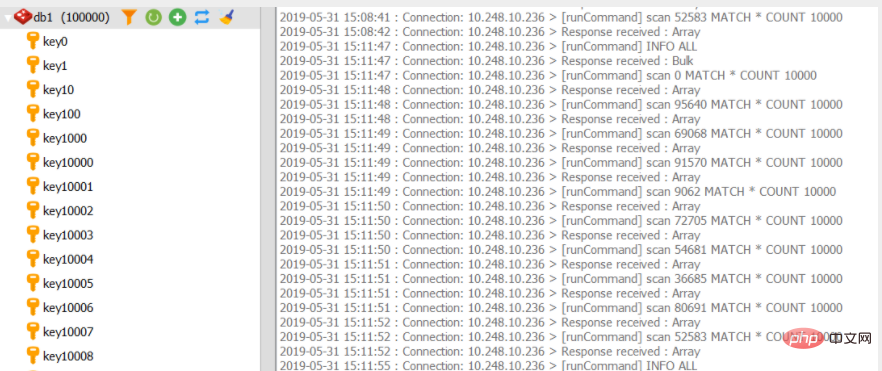Detailed explanation of the use of Scan command in Redis
The following column Redis Tutorial will introduce you to the detailed explanation of the use of the Scan command in Redis. I hope it will be helpful to friends in need!

There is a classic problem in Redis. In the case of a huge amount of data, it is similar to searching for a certain There are two ways to provide information about the Key of a rule.
The first is the keys command, which is simple and crude. Due to the single-threaded feature of Redis, the keys command is executed in a blocking manner, and keys is implemented in a traversal manner. The complexity is O(n). The more keys in the Redis library, the greater the search implementation cost and the longer the blocking time.
The second is the scan command, which implements key value search in a non-blocking manner. In most cases, it can replace the keys command and is more optional.
Write 100,000 keys below** *: Test data in value*** format (ps: If you use pipeline, 1w is one transaction, and each transaction is completed in seconds)
# -*- coding: utf-8 -*-
# !/usr/bin/env python3
import redis
import sys
import datetimedef create_testdata():
r = redis.StrictRedis(host='***.***.***.***', port=***, db=0, password='***')
counter = 0
with r.pipeline(transaction=False) as p:
for i in range(0, 100000):
p.set('key' + str(i), "value" + str(i))
counter = counter + 1
if (counter == 10000):
p.execute()
counter = 0
print("set by pipline loop")
if __name__ == "__main__":
create_testdata()For example, here are the keys starting with key111?
If you use the keys command, execute keys key1111* to find out all at once.

Similarly, if you use the scan command, use scan 0 match key1111* count 20

The syntax of scan is :SCAN cursor [MATCH pattern] [COUNT count] The default COUNT value is 10.
The SCAN command is a cursor-based iterator. This means that every time the command is called, it needs to use the cursor returned by the previous call as the cursor parameter of the call, so as to continue the previous iteration process.
The scan 0 match key1111* count 20 command is used here to complete this query. Surprisingly, no results were found at the beginning. This depends on the principle of the scan command.
When scanning traverses keys, 0 represents the first time, key1111* represents matching according to the pattern starting with key1111, and the 20 in count 20 does not represent the output of qualified keys, but a dictionary that limits the server to a single traversal. Number of slots (approximately equal to).
So, what is slot data? Is this slot a slot in the Redis cluster? the answer is negative. In fact, the answer is already given in the picture above.
If the number of "dictionary slots" mentioned above is the slot in the cluster, and we know that the number of slots in the cluster is 16384, then after traversing 16384 slots, we will definitely be able to traverse all the key information.
It is clear from the above It can be seen clearly that when the number of traversed dictionary slots is 20,000, the cursor still has not completed the traversal results, so this dictionary slot is not equal to the concept of slot in the cluster.
After testing, when scanning, how many COUNT values can be traversed to completely match the key that meets the conditions is related to the number of keys of the specific object.
If the count exceeds the number of keys to scan, All keys that meet the conditions will be found at one time. For example, if the number of keys is 100,000, and 200,000 dictionary slots are traversed at one time, the result will definitely be completely traversed.

The scan instruction is a series of instructions. In addition to traversing all keys, it can also traverse the specified container collection.
zscan traverses the elements of the zset collection,
hscan traverses the elements of the hash dictionary, and
sscan traverses the elements of the set collection.
The first parameter of the SSCAN command, HSCAN command and ZSCAN command is always a database key (a specified key).
In addition, when using redis desktop manager, when refreshing a certain library, the console automatically refreshes the scan command continuously, so you know what it is doing

The above is the detailed content of Detailed explanation of the use of Scan command in Redis. For more information, please follow other related articles on the PHP Chinese website!

Hot AI Tools

Undresser.AI Undress
AI-powered app for creating realistic nude photos

AI Clothes Remover
Online AI tool for removing clothes from photos.

Undress AI Tool
Undress images for free

Clothoff.io
AI clothes remover

Video Face Swap
Swap faces in any video effortlessly with our completely free AI face swap tool!

Hot Article

Hot Tools

Notepad++7.3.1
Easy-to-use and free code editor

SublimeText3 Chinese version
Chinese version, very easy to use

Zend Studio 13.0.1
Powerful PHP integrated development environment

Dreamweaver CS6
Visual web development tools

SublimeText3 Mac version
God-level code editing software (SublimeText3)

Hot Topics
 How to build the redis cluster mode
Apr 10, 2025 pm 10:15 PM
How to build the redis cluster mode
Apr 10, 2025 pm 10:15 PM
Redis cluster mode deploys Redis instances to multiple servers through sharding, improving scalability and availability. The construction steps are as follows: Create odd Redis instances with different ports; Create 3 sentinel instances, monitor Redis instances and failover; configure sentinel configuration files, add monitoring Redis instance information and failover settings; configure Redis instance configuration files, enable cluster mode and specify the cluster information file path; create nodes.conf file, containing information of each Redis instance; start the cluster, execute the create command to create a cluster and specify the number of replicas; log in to the cluster to execute the CLUSTER INFO command to verify the cluster status; make
 How to read redis queue
Apr 10, 2025 pm 10:12 PM
How to read redis queue
Apr 10, 2025 pm 10:12 PM
To read a queue from Redis, you need to get the queue name, read the elements using the LPOP command, and process the empty queue. The specific steps are as follows: Get the queue name: name it with the prefix of "queue:" such as "queue:my-queue". Use the LPOP command: Eject the element from the head of the queue and return its value, such as LPOP queue:my-queue. Processing empty queues: If the queue is empty, LPOP returns nil, and you can check whether the queue exists before reading the element.
 How to clear redis data
Apr 10, 2025 pm 10:06 PM
How to clear redis data
Apr 10, 2025 pm 10:06 PM
How to clear Redis data: Use the FLUSHALL command to clear all key values. Use the FLUSHDB command to clear the key value of the currently selected database. Use SELECT to switch databases, and then use FLUSHDB to clear multiple databases. Use the DEL command to delete a specific key. Use the redis-cli tool to clear the data.
 How to configure Lua script execution time in centos redis
Apr 14, 2025 pm 02:12 PM
How to configure Lua script execution time in centos redis
Apr 14, 2025 pm 02:12 PM
On CentOS systems, you can limit the execution time of Lua scripts by modifying Redis configuration files or using Redis commands to prevent malicious scripts from consuming too much resources. Method 1: Modify the Redis configuration file and locate the Redis configuration file: The Redis configuration file is usually located in /etc/redis/redis.conf. Edit configuration file: Open the configuration file using a text editor (such as vi or nano): sudovi/etc/redis/redis.conf Set the Lua script execution time limit: Add or modify the following lines in the configuration file to set the maximum execution time of the Lua script (unit: milliseconds)
 How to use the redis command line
Apr 10, 2025 pm 10:18 PM
How to use the redis command line
Apr 10, 2025 pm 10:18 PM
Use the Redis command line tool (redis-cli) to manage and operate Redis through the following steps: Connect to the server, specify the address and port. Send commands to the server using the command name and parameters. Use the HELP command to view help information for a specific command. Use the QUIT command to exit the command line tool.
 How to set the redis expiration policy
Apr 10, 2025 pm 10:03 PM
How to set the redis expiration policy
Apr 10, 2025 pm 10:03 PM
There are two types of Redis data expiration strategies: periodic deletion: periodic scan to delete the expired key, which can be set through expired-time-cap-remove-count and expired-time-cap-remove-delay parameters. Lazy Deletion: Check for deletion expired keys only when keys are read or written. They can be set through lazyfree-lazy-eviction, lazyfree-lazy-expire, lazyfree-lazy-user-del parameters.
 How to implement redis counter
Apr 10, 2025 pm 10:21 PM
How to implement redis counter
Apr 10, 2025 pm 10:21 PM
Redis counter is a mechanism that uses Redis key-value pair storage to implement counting operations, including the following steps: creating counter keys, increasing counts, decreasing counts, resetting counts, and obtaining counts. The advantages of Redis counters include fast speed, high concurrency, durability and simplicity and ease of use. It can be used in scenarios such as user access counting, real-time metric tracking, game scores and rankings, and order processing counting.
 How to optimize the performance of debian readdir
Apr 13, 2025 am 08:48 AM
How to optimize the performance of debian readdir
Apr 13, 2025 am 08:48 AM
In Debian systems, readdir system calls are used to read directory contents. If its performance is not good, try the following optimization strategy: Simplify the number of directory files: Split large directories into multiple small directories as much as possible, reducing the number of items processed per readdir call. Enable directory content caching: build a cache mechanism, update the cache regularly or when directory content changes, and reduce frequent calls to readdir. Memory caches (such as Memcached or Redis) or local caches (such as files or databases) can be considered. Adopt efficient data structure: If you implement directory traversal by yourself, select more efficient data structures (such as hash tables instead of linear search) to store and access directory information






